At their heart, blockchains are trust machines. Evaluating trust, let alone a chain’s performance, is not a routine task. Amongst the many tools used to quickly evaluate a chain’s performance, transactions per second (TPS) stands out as the most widely recognized one. TPS is often characterized as a reflection of a chain’s throughput, when in reality The question remains: how do we value throughput?
The Tie Research
True Network Value: A Novel Throughput Metric
New blockchains pop up now and again, claiming TPS rates in the tens of thousands. It’s important to keep in mind that centralized services provide the maximum throughput currently available (Visa can do more than 47,000 TPS).
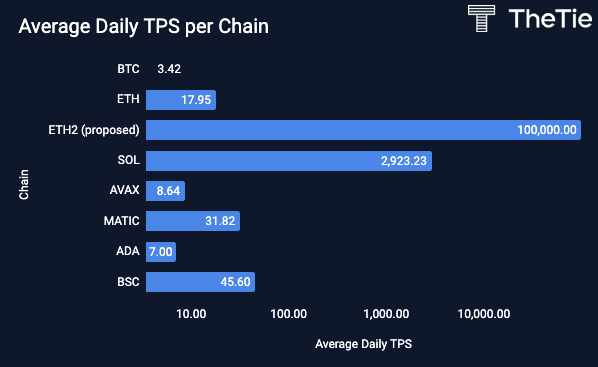
How significant is speed in the eyes of the consumer? In the past ten years, Amazon has discovered that every 100 milliseconds of latency cost them 1% of sales. Recently, Akamai discovered that 100-millisecond delays impacted conversion rates by 7% across various large retail sites, while 53 percent of mobile site users deserted pages that took longer than three seconds to load.
Looking at speed without incorporating other key on-chain metrics should not be the end-all-be-all metric of future success. Intuitively, increased transaction speed comes at the expense of network security, yet this is not reflected in a standard TPS measure. For instance, Solana claims an average of over 2,000 TPS, but is known for patchy performance. In this piece, we re-analyze what throughput means, present a new valuation method, and evaluate this method across chains.
Defining Throughput
Throughput is commonly defined as the amount of data that is successfully transferred between nodes (in seconds). The go-to metric used to measure throughput is TPS, but when isolated, TPS does not provide an encapsulating image of what a network’s true value is. TPS relies on a combination of two variables:
- Transactions per block
- Block Time
Resulting in: TPS = Transactions per block / block time (seconds).
True network value depends on methods of access, network loads, and error rates, among others. In fact, advertised throughput is usually depicted as an idealized scenario, and, as a result, the realized throughput is typically a far cry from any of those claims. Furthermore, in the cases where Layer 1’s TPS is true to the advertised value, security tends to be compromised.
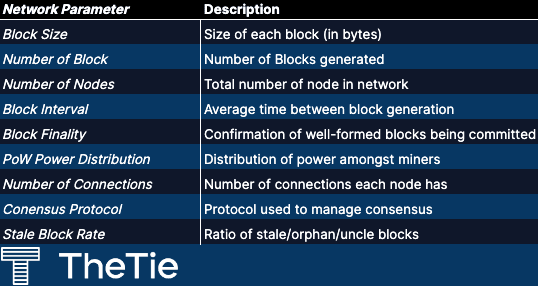
In order to properly value throughput, it’s important to understand that throughput is not just the ability of transference of data. Rather, the throughput of public blockchains should be derivative of the economic transference of value. So before creating a model appraising value-transference systems, let’s break down its components.
Components of Throughput
We gathered key on-chain components, defined transactional parameters, and incorporated a few indispensable network security components. There are a multitude of factors that we could have chosen to incorporate, but initially used the components of TPS as a naive springboard and focused on dissecting block-time.

Notice how the description of the execution and verification phase are largely the same. This is because we take the assumption that the amount of time required by both is equal; when we simplify, change in execution phase = change in verification phase.
There are a number of drawbacks we encountered when trying to put the dissected components of Block Time into practice. For one, block time itself is a flawed metric, as it does not take into account when a transaction is final. Moreover, while block interval and size dictate a large part of network security, it does not provide the entire decentralized picture as it does not account for the number of stakers/validators.
True Network Value
In an attempt to plug these pitfalls, we had to change the way we looked at throughput. Earlier, we discussed the idea of throughput as being an economic transference of value. In order to develop a system that is able to holistically appraise a value transference system, it’s important we succinctly aggregate key variables.
We propose the True Network Value (TNV) model, consisting of three variables:
- Block Size (βs)
- Number of validators (Vn)
- Time-to-Finality (δf)
For Ethereum and many other chains, block size is bound by how many units of gas can be spent per block and is variable, being a perfect proxy for economic value per block. In general, block size regulates the throughput of a blockchain system. The more data a block can store, the slower the propagation speed, resulting in a higher stale block rate and reduced security (all else being constant).
Time-to-Finality (TTF) is dependent on the average number of block confirmations and block time. TTF stems from the economic impractically of reversing blockchain transactions, as well as blocks to finality, though it’s more of a probability, i.e., the probability for a transaction to be 100% finalized. TTF is not static and depends on the transaction being sent. The difference between block time and TTF is a critical distinction, as they are not the same. Block time is the average amount of time it takes for the computational power of the nodes to find a solution to the current hash, though this does not tell when a block has reached finality. Block time allows one to understand what the eventual block finality is. TTF measures the time from transaction execution to confirmation, with an extremely high probability of irreversibility. Thereby making it an excellent proxy for latency and a better speed gauge, as it helps to know when a transaction is final.
Finally, we consider the nature of the system’s decentralized security by factoring the number of validators or stakers.
Giving us:
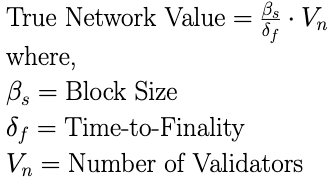
A high TNV translates to an efficient, fast, network with plenty of validation security.
Key Takeaways
Now let's compare TNV against some major chains.
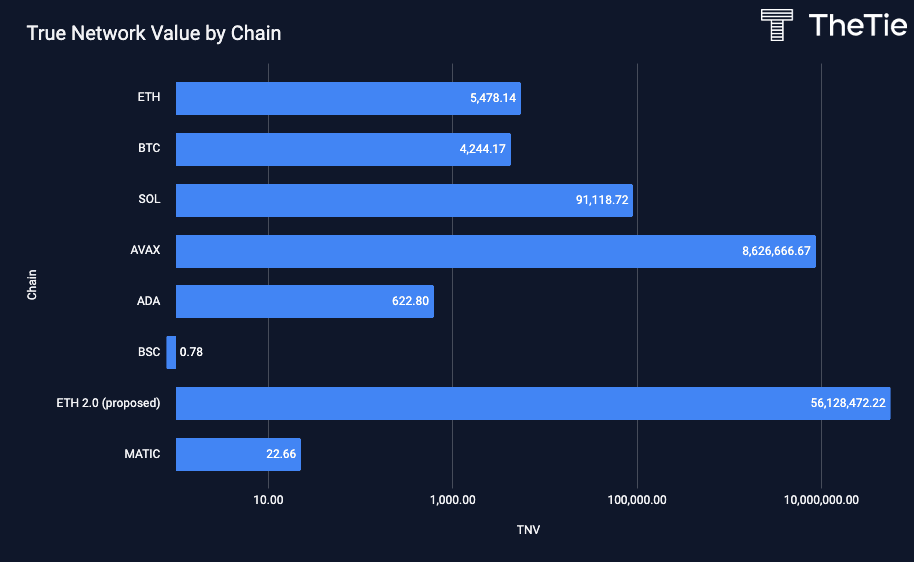
With the proposed upgrade in block size for ETH2, as well as the outstanding number of stakers securing the network prior to the Merge, ETH2 races ahead of the pack. Binance Smart Chain remains relatively stagnant as a result of low block size capacity and low validator counts. Avalanche came as a surprise to some, though it is to be expected, as Avalanche has the fastest TTF, sufficient block size, and a good amount of validators. Solana remains ahead of Ethereum and Bitcoin as a result of having the second lowest TTF, a block size of more than 1 MB, and more than 1,000 stakers securing the network.
TNV vs TPS
When looking at just TPS, Solana seemingly has a big leg up on other chains. Let’s compare how TNV differs from TPS in the case of Solana vs Avalanche.
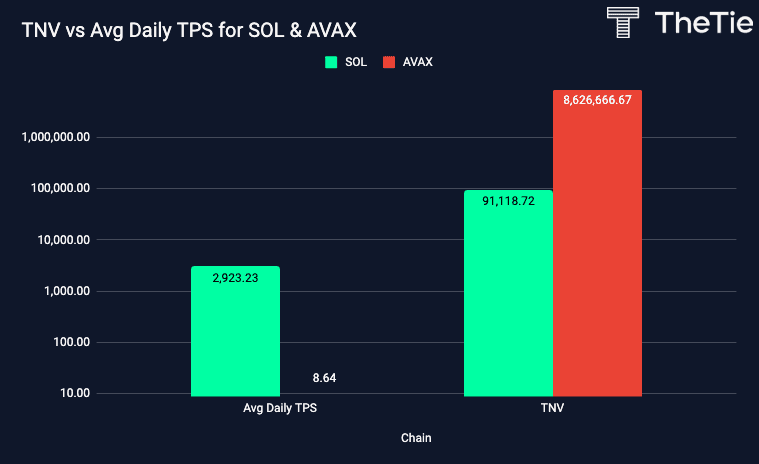
There are a couple factors that account for this vast differential. Recall that TPS is dependent on block time, whereas TNV is dependent on time-to-finality. Avalanche maintains the single fastest time-to-finality amongst top ten chains with 0.15 seconds, while Solana has a 25 second TTF. The TTF made all the difference, as Solana has a greater block size capacity and more validators. Avalanche’s low latency means transactions will be cleared and final at an incredible speed, resulting in low congestion and a more secure network. In January 2022, Solana suffered 6 congestion events that led to severe outages. One could argue that the congestion is a sign of extremely high user demand for a cheap and fast chain. As a result of it’s TNV, if the block size or the number of validators doesn’t drastically increase, the network outages Solana faces will continue to grow worse and more frequent.
Wrapping Up
True Network Value holistically demonstrates a chain’s performance by taking into account block size, time-to-finality, and validator count. This metric is still a work in progress, as there are a some factors it lacks. TNV does not account for geographical distribution of validators. This aspect is quite key to determining the level of decentralization. A potential solution could be to replace the number of validators with the Nakamoto coefficient, giving us a true quantification of a network’s degree of decentralization. We would also like to further explore the relationship between throughput and stale or “uncle” blocks and what it means for network security. The TNV metric seeks to redefine how throughput is valued and thought about. The TNV metric seeks to remedy the shortcomings of TPS by providing a comprehensive view of a system’s ability to conduct value transference. Given the data reflected by the TNV model, Avalanche and Ethereum (post-merge) are best poised to accelerate strongest into the next bull market.
This report is for informational purposes only and is not investment or trading advice. The views and opinions expressed in this report are exclusively those of the author, and do not necessarily reflect the views or positions of The TIE Inc. The Author may be holding the cryptocurrencies or using the strategies mentioned in this report. You are fully responsible for any decisions you make; the TIE Inc. is not liable for any loss or damage caused by reliance on information provided. For investment advice, please consult a registered investment advisor.
Sign up to receive an email when we release a new post